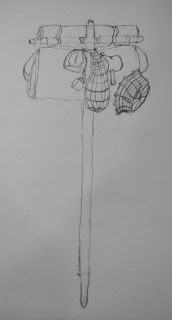There is that classic image of hobo walking with a bag on a stick over the shoulder.
Believe it or not, that stick has a name: a bindle. It might derive from the German word for packet. While I hate hobos as in murder hobos, we can actually steal a good idea from them, their baggage.
 |
The Sarcina
|
The Romans had a version of the bundle on a stick. It was called sarcina. Because they used a forked stick or stick with an arm, it was called a furca or a fork. Its function was largely the same as the hobo's bindle, to redistribute a load to the shoulder and to allow one hand free.
The legionary's sarcina was wildly better than an adventure's backpack. The furca carried a loculus (satchel), a cloak bag, a cooking pot, a patera (mess kit), spikes (also called wolves), and a net bag for food. On the top, there was a rolled object, perhaps a bedroll which also contained several tools, an axe, a turf cutter, hammer or mattock, saw, and sickle. It's unclear if each soldier carried each and every tool or if they were carrying just one of many.
In any event, the items were tied to the furca in such a way that allowed them to swing front to back but not side to side. This aids marching and prevents a staggering gate. Additionally, the swinging allows for an important secondary function a bindle doesn't have. If you dropped the sarcina, the weight forced the furca's end to point upwards. This helped with recovery, but also put a vaguely pointy stick between the carrier and an opponent.
While one person doing this seems like a very haphazard barrier, a legion's worth of men doing it as a group made an instant wall.
In camp, the unloaded furca would be used to mark a soldier's spot and to hold his armor and helmet off the ground. In an effort to avoid a baggage train, the Roman soldiers marched in full armor and didn't remove it until they were making camp. Their shields were carried across the back in a bag with straps, like a backpack. This probably explains why they didn't use backpacks.
Removing the armor at the end of the march felt good and let the soldier get to work digging a trench and creating a berm to keep people and creatures out.
The netted bag carried 3 days of food. Romans avoided carrying more because they generally moved by road, so from one home base to another destination where food was available. It also seems they carried hardtack which didn't count as food until everything else was gone. The Romans would use their sickle to harvest foods in the field before resorting to the hardtack. It was really disliked.
You'll also notice they didn't carry shovels. Instead, they would use their pickaxe or turf cutter to remove earth and put it in a basket. When you work as a team, this is better for moving large amounts of earth. You can form a chain to quickly make berms or create ditches.
As a DM, if a character with a backpack told me they had a pickaxe, a turf cutter, a sledgehammer, a cloak bag, iron rations, in addition to rope, armor, weapons, and rations, I would call B.S. immediately. Because that is how backpacks don't work. If you ask a modern soldier how overloaded he or she is, you'd be shocked and not a bit surprised at how fast they take chances and dump that crap to get other things done. Soldiers, time immemorial, are savvy and sneaky.
However, a sacrina does actually allow troops to move and fight.
The Romans made this work because they managed expectations. No shovels because they don't make sense. No ropes because they have 800+ guys who could turn net bags into rope overnight. No torches because they
almost never fought at night and didn't want to expose guards and scouts with flaming objects. They carried 3 days of food because they journeyed by road from one destination with supplies to another.
Players will like it because the loculus or satchel is backpack sized container that is full of a person's belongings and treasures. Everything is simply organized so as to stop the carrier from fumbling through a whole backpack-deep pile of stuff to get one thing. Everything is a one container reach. It's super handy.
DM should like it because it removes hard tracking of a crazy number of things like axes and food. Eating a meal in town reduces food consumption on the road. Assuming a party is marching as soldiers mean no one asks the slow guy to run him or herself to exhaustion. Knowing that there are only 3 days of rations means the party must have a destination within 5 days to make it.
The
D&D Rules Cyclopedia equipment list gives a price of less than 40 gps for everything needed to create a sacrina. It reminds me of a cheaper version of the Standard Equipment pack from Star Frontiers Basic. It's a good option, why not let your players give it a try?













